How To Install Centos 7 With Gui
CentOS is an open-source Linux distribution based on Red Hat Enterprise Linux (RHEL). CentOS 7 is viewed as the preferred option for web hosting due to its stability and agile programmer community.
In this tutorial, learn how to install CentOS 7 in a few simple steps.
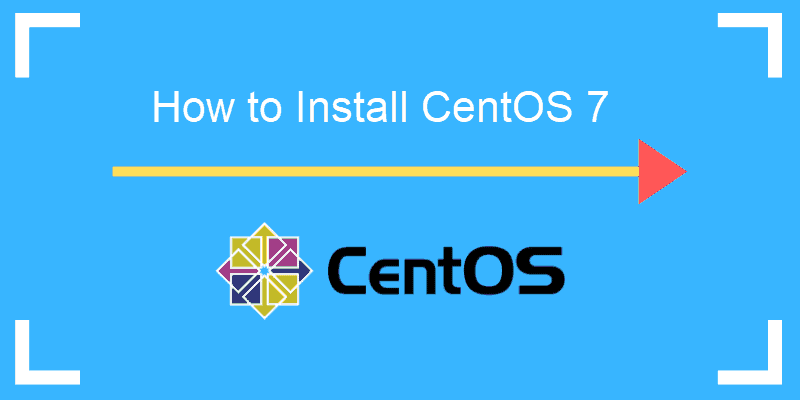
Prerequisites
- Recommended minimum of 10GB of costless disk space
- CentOS 7 ISO install file
Follow the Steps to Install CentOS 7
If you are only looking to update or upgrade CentOS, see How to Upgrade or Update CentOS.
Step 1: Download CentOS 7
To download the official and up-to-date CentOS 7 ISO file, navigate to https://www.centos.org/download/.
Our recommendation for non-enterprise environments is to download the DVD ISO option, which includes the GUI. Nosotros recommend the Minimal ISO option only for production enterprise environments.
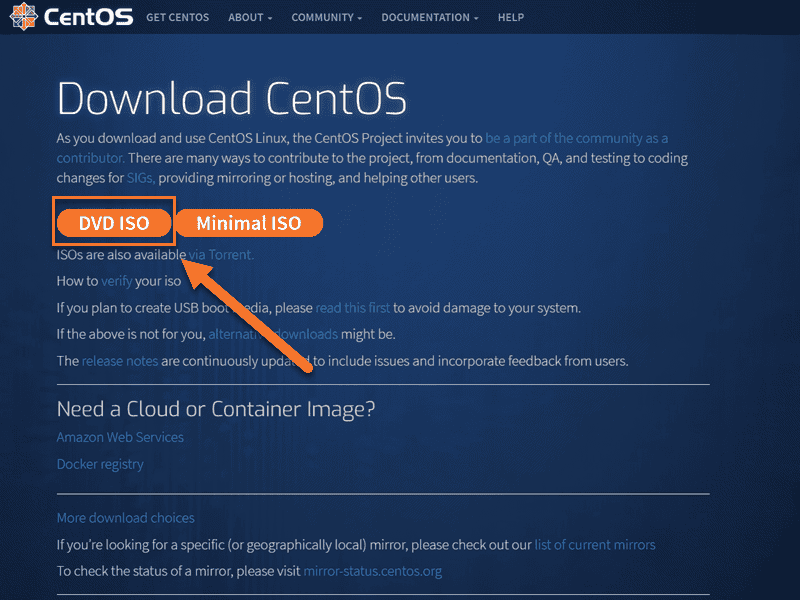
Note: Important information to go along in listen for CentOS-based systems is the CentOS half-dozen EOL in November 2022.
Step two: Create Bootable USB or DVD
At present that you accept downloaded the ISO image, yous can create a bootable USB, burn it on a DVD or load the image on a VM.
Several applications can aid you create a bootable USB. We recommend using Etcher. Download the application for your arrangement (Windows, macOS or Linux), install and run.
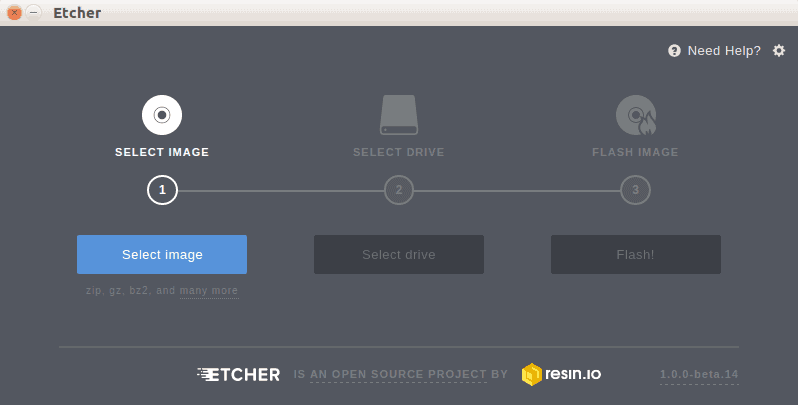
The setup is intuitive and like shooting fish in a barrel:
- Select the CentOS 7 ISO prototype.
- Insert the USB flash.
- Discover the USB and select information technology in the Select bulldoze pace.
- Click Wink.
Pace three: Boot the CentOS ISO File
Upon booting the CentOS seven ISO file, you lot can brainstorm the installation process. To exercise so, select Install CentOS 7. That volition start the installer's graphical interface.
If you are booting from a USB, click the Install to Hard Drive icon on the desktop. That will open the installation sorcerer.
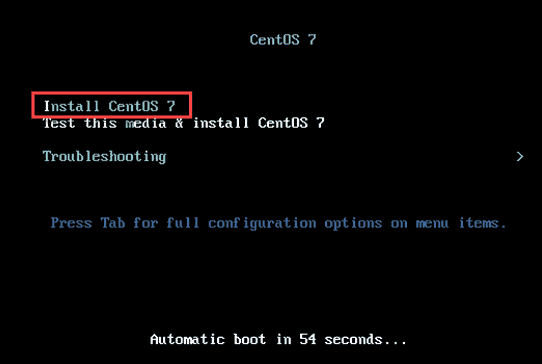
Footstep four: Install CentOS
Before starting the installation process itself, select which linguistic communication you would similar to use during installation. The default option is English.
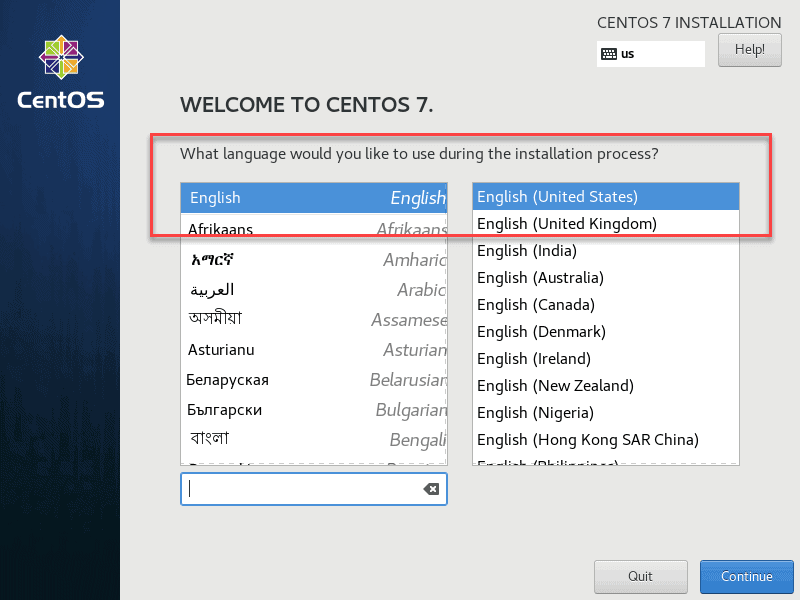
Click Proceed to ostend your choice.
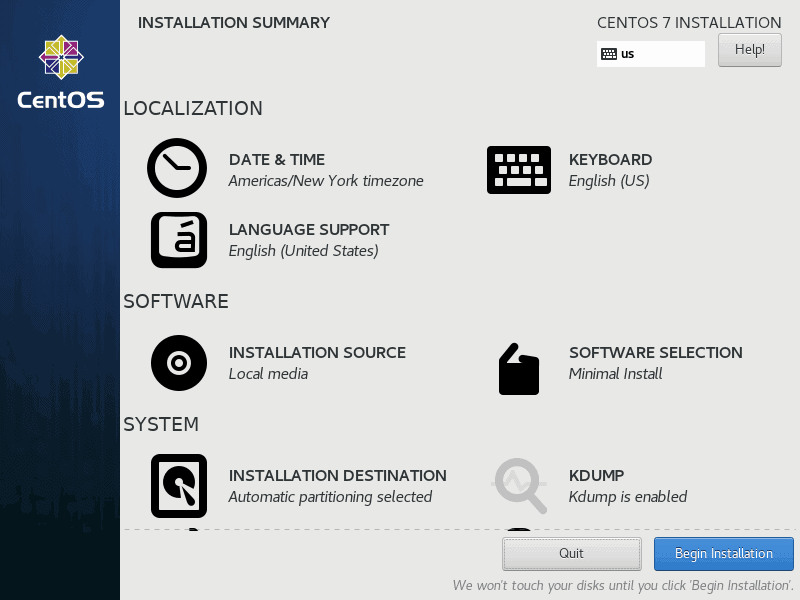
At that place are a couple of settings you would desire to configure. All items marked with a warning icon must exist configured before yous brainstorm the installation.
Organization configurations outlined beneath may differ based on use case.
Set Engagement and Fourth dimension
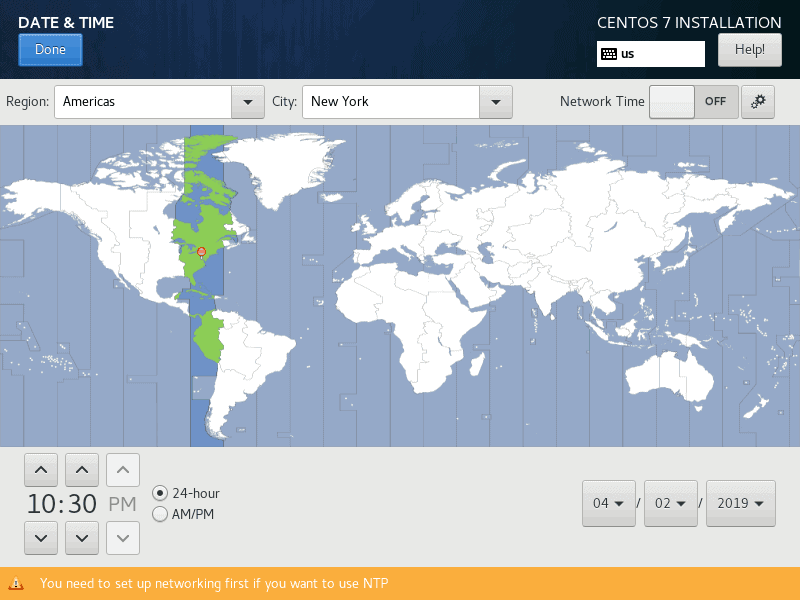
To fix a date and fourth dimension for the arrangement, click the Engagement & Time icon nether the Localization heading. Select a region/time zone on the map of the earth every bit seen below. Once you have selected your time zone, hit Done to save your changes.
Keyboard Layout
Select the Keyboard option under the Localization heading to set the keyboard layout.
The organization default is English language (United states) and the language you selected in the initial window. Click the plus icon to add more layouts. Move a layout to the peak of the list to arrive the default option.
Click the Options button to define a primal combination for switching between keyboard layouts. When you are satisfied with the settings defined, select the Done push to confirm the changes.
System Language
Side by side, select the Language Support option nether the Localization heading. The language selected in the Welcome to CentOS 7 window will be the default system language. If necessary, select additional languages and hit the Done button once you are finished.
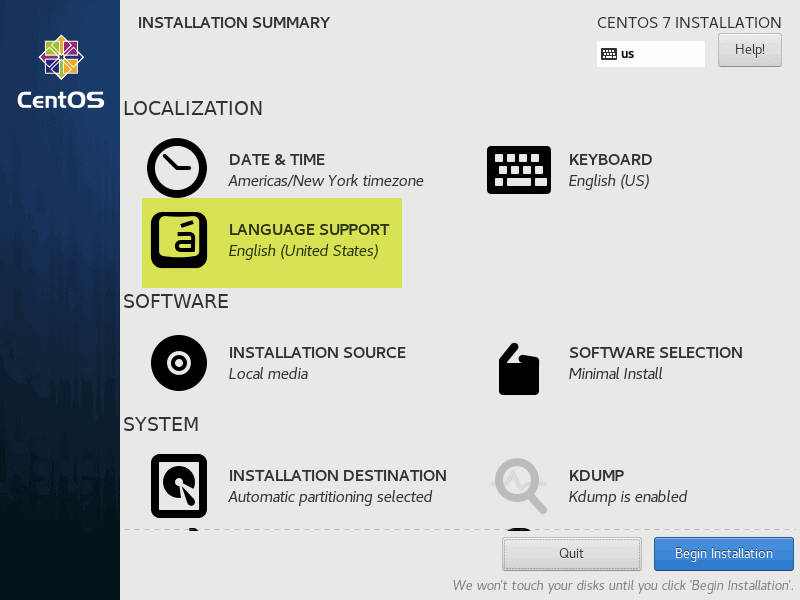
Software Choice
Select the Software Selection option under the Software heading. Yous will see a list of predefined Base of operations Environment options and optional add together-ons. This part entirely depends on your needs.
- Minimal Install. This is the most flexible and least resource-enervating option. Excellent for production surroundings servers. Exist prepared to customize the environment.
- Predefined Server Options. If yous are 100% certain about the role of your server and don't want to customize it for its role, select ane of the predefined server environments.
- GNOME Desktop and KDE Plasma Workspaces. These environments include a total graphical user interface.
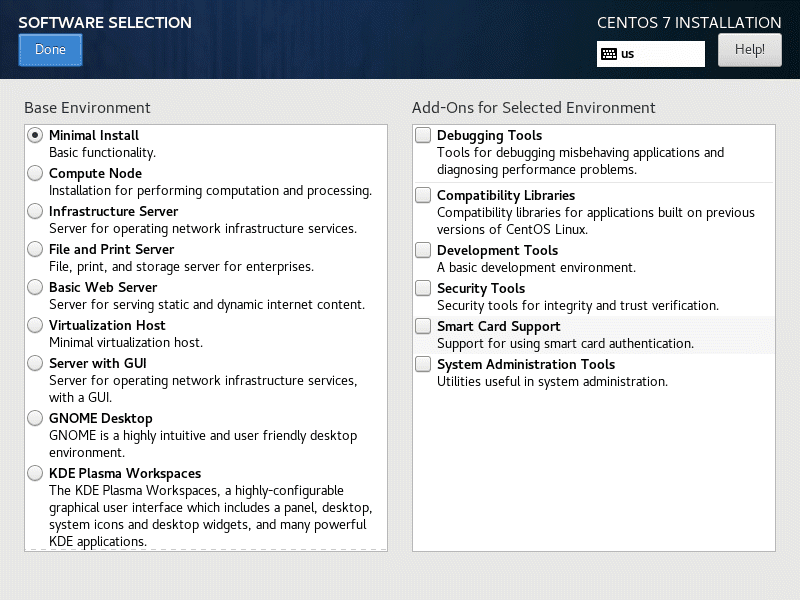
When you take selected the base environment and optional add-ons, click the Done push. Wait for the system to check for software dependencies before you motion on to the next option.
Select Installation Destination
Click the Installation Destination option nether the System heading. Cheque your machine'southward storage under the Local Standard Disks heading. CentOS vii will exist installed on the selected deejay.
Partition
Option 1: Automatic Sectionalisation
Under the Other Storage Options heading, select the Automatically configure partitioning checkbox. This ensures the selected destination storage disk will automatically partition with the /(root), /domicile and bandy partitions. It volition automatically create an LVM logical volume in the XFS file system.
If yous do not have enough free space, yous can repossess disk space and instruct the system to delete files.
When finished, click the Done push button.
Option 2: Manual Partitioning
Select the I will configure partitioning checkbox and choose Washed.
If you want to utilise other file systems (such every bit ext4 and vfat) and a non-LVM partitioning scheme, such as btrfs. This will initiate a configuration pop-up where you can gear up up your division manually.
This is an advanced choice that depends on your requirements.
Configuring KDUMP
KDUMP is enabled by default.
To disable the KDUMP kernel crash dumping mechanism, select the KDUMP choice under the Organisation heading and uncheck the Enable kdump checkbox. Click the Done push to confirm your changes.
Note: KDUMP captures organisation information at the fourth dimension of a crash. It helps you diagnose the crusade of the crash. When enabled, kdump reserves a portion of organisation retentivity.
Network and Hostname
Click the Network & Host Proper name option under the Arrangement heading.
For the hostname, type in the fully qualified domain name of your system. In our example, we will set up the Hostname as my_server.phoenixnap.com, where my_server is the hostname while phoenixnap.com is the domain.
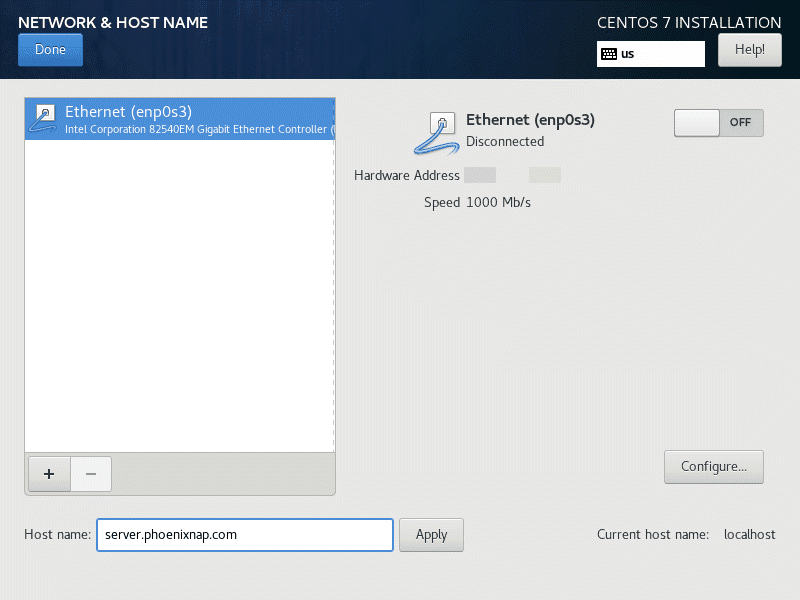
Select Configure… and select to add IPv4 settings or IPv6 settings depending on what you take. Add together static IP addresses to help place your figurer on the network. Bear in mind that your network surroundings'south settings define these values.
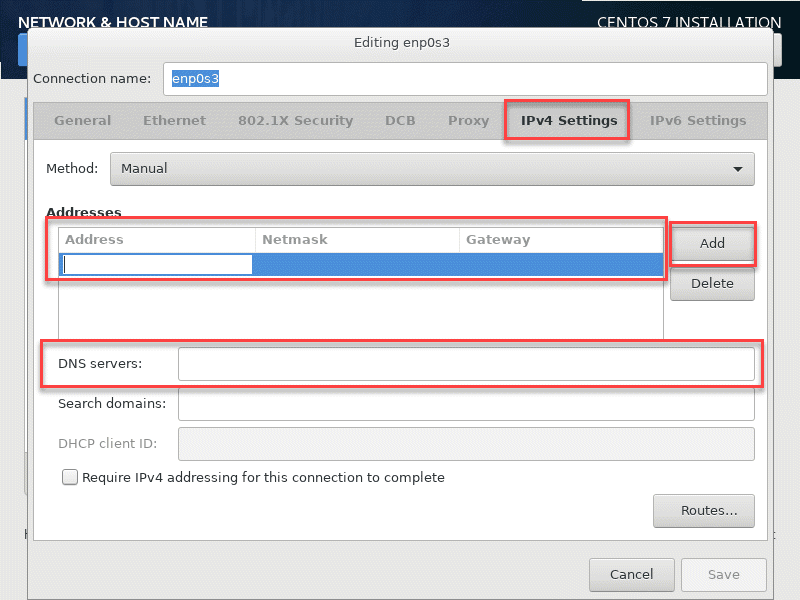
To add a static IP address:
- Select Transmission from the Method drop-down.
- Click the Add push button to add a static IP accost.
- Enter the information for your network domain.
- IP Accost
- Netmask Accost
- Gateway Address
- DNS Servers Address
- Click Save to confirm your changes.
By default, all detected Ethernet connections are disabled. Click the ON/OFF toggle to enable the connection. Afterward the installation of CentOS, follow our guide to learn more than details about configuring your network settings.
Annotation: Is CentOS the best option for your server? Refer to the Ubuntu VS CentOS article to encounter a comparison between the ii and decide which one is best for yous.
Security Policy
Select the Security Policy choice under the System heading. Cull a profile from the list and striking Select profile. Hitting the Done button to confirm your option.
Commencement the Installation Process
Once everything is set up up co-ordinate to your liking, hit Begin Installation to outset the install. This will start the initial installation process.
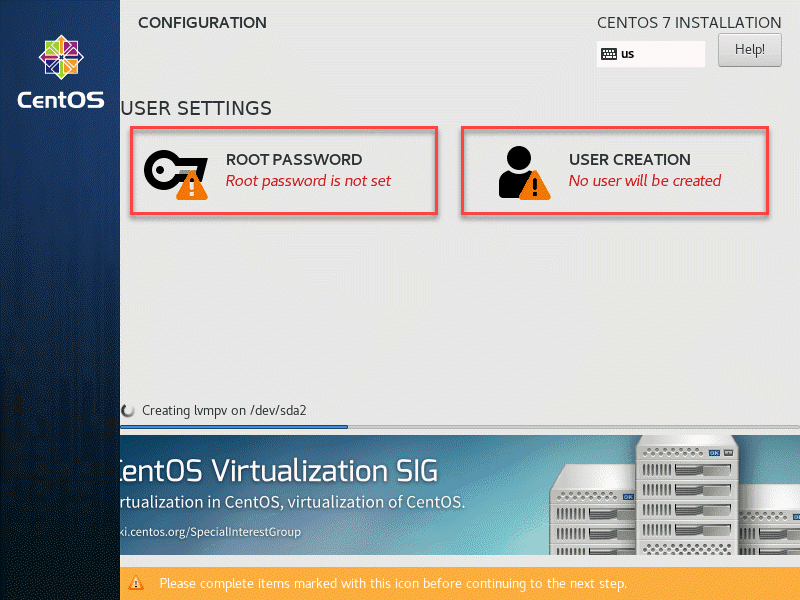
Ascertain Root Password
To ascertain the root user, select the Root Password icon.
Select a Root Password and re-enter it in Ostend field.
Root user accounts should consist of at least 12 characters, including uppercase and lowercase letters, numbers, and special characters. Nosotros cannot stress enough the importance of a well-defined root password.
Click the Done button to continue.
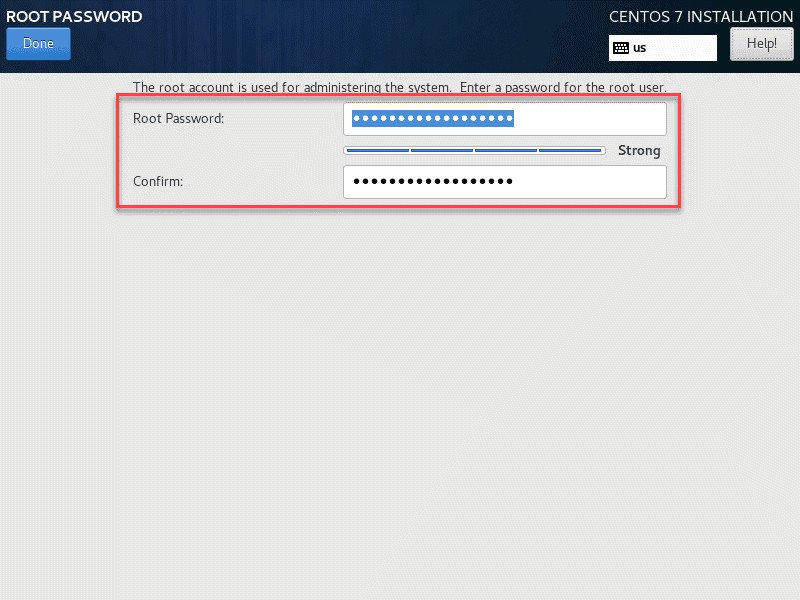
Create User
To begin, select the User Creation option.
Add together a new arrangement account user by defining the full name, user name, and password. We recommend you cheque the Make this user administrator and Crave a password to use this business relationship checkboxes. This will grant the user root privileges.
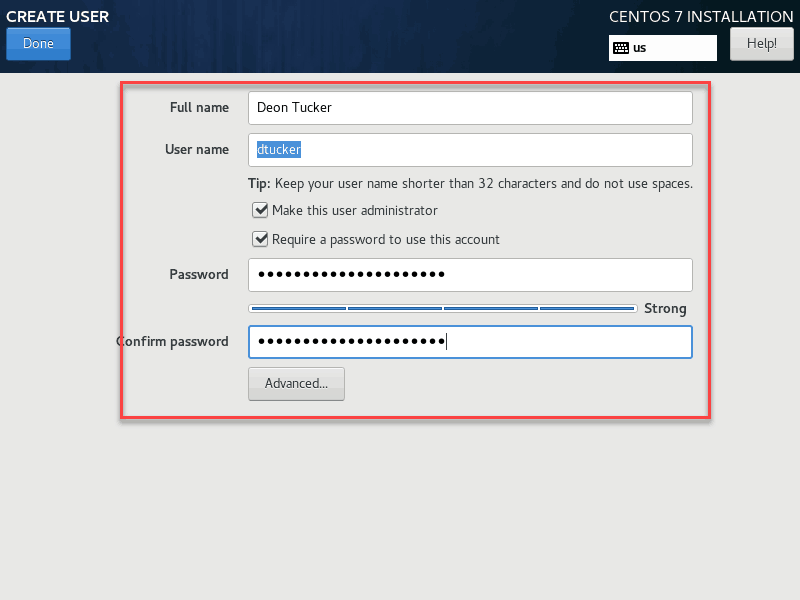
After yous fill in all of the fields and define a secure password, select Done in the upper-left corner of the screen.
Wait for the installation process to consummate.
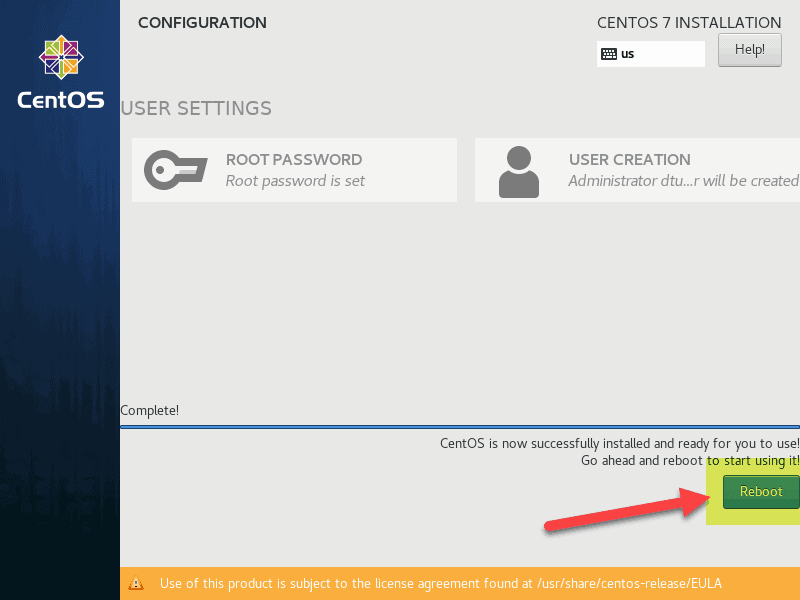
Before yous start using your new CentOS installation, reboot the arrangement. Click the Reboot push.
Log into the system by using the credentials you lot defined previously.
Conclusion
This tutorial outlined how to install CentOS 7. By post-obit this guide, you should have a successful installation and boot right into the system.
Was this article helpful?
Yes No
Source: https://phoenixnap.com/kb/how-to-install-centos-7
Posted by: gomezhured1993.blogspot.com


0 Response to "How To Install Centos 7 With Gui"
Post a Comment